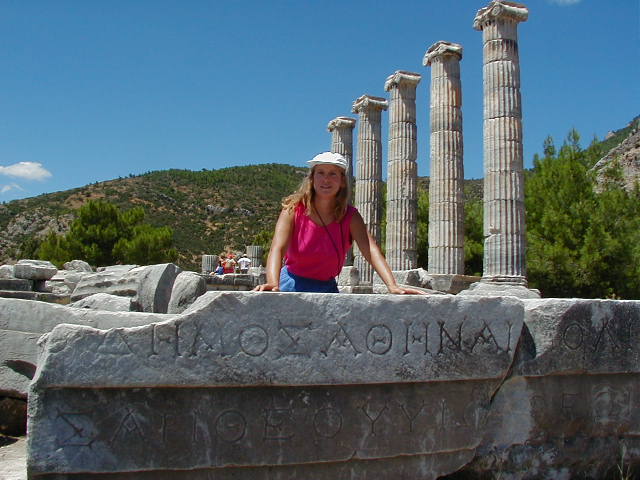
Sparta a beautiful town near the river Evrotas, located in the centre of the Peloponnese in southern Greece, is the capital of the prefecture of Lakonia. SPARTA ( known in Greek as Sparti) has a history which dates back to the Neolithic period, at least 3,000 years before Christ.
Even in its most prosperous days, it was merely a group of five villages with simple houses and a few public buildings. The passes leading into the valley of the Evr�tas were easily defended, and Sparta had no walls until the end of the 4th century BC. The city itself was destroyed by the Goths under their king, Alaric I, in 396 AD.
Modern Sparta, founded by the government in 1834, occupies part of the site of ancient Sparta and is the capital of the department of Lacon�a. Excavations of the ancient city have uncovered ruins of temples and public buildings as well as a theatre dating from the Roman period, but the sparse remains are insignificant for a city of such renown in antiquity.
Crete In the southernmost part of Greece, the island of Crete lies in the heart of the Mediterranean Sea. Crete is a blessed land that for thousands of years has been the cultural and commercial crossroads of three continents, Europe, Asia and Africa.
In the birthplace of Zeus, bloomed the glorious Minoan civilization and lived great personalities of culture such as the great painter Domenicos Theotokopoulos, (called "El Greco") and Nikos Kazantzakis the author known for his Zorba the Greek.
Crete is a spirited and enchanting place with a wonderful climate. Ravishing scenery, picturesque harbours, ancient Minoan palaces and Byzantine churches are but a few of Crete's pleasures. Add to that the friendliness of the Cretan people and one has the setting for a memorable conference destination. Crete demands to be explored by car or by jeep and there are several interesting excursions that may be organized. Heraklion, the capital of the island with its world class Archaelogical Museum and the Palace of Knossos dating back to 1500BC, the town of Rethymno with its Venetian Fortress and the old Turkish quarter with mosques and minarets, the town of Chania, a typical Venetian town with a small secluded harbour with picturesque houses and cafes and last but not least, the port of Aghios Nikolaos and the village of Elounda around the Bay of Mirabello are all visiting points. Trekking through the Samaria Gorge, mountain biking on the Lassithi Plateau with its countless windmills, listening to traditional Cretan music played by the lyra during one of the Cretan nights and shopping for handicrafts and local wines can be a part of interesting activities.
Mykonos cosmopolitan character has made it famous as an international tourist resort. However, even the most unsuspicious visitor realises immediately that Mykonos is not only a crazy bon-viveur but also a beautiful, picturesque island with an all-white Hora (the main village) next to the crystal-clear blue waters of the Aegean Sea.
An island that enchants the visitor with the golden, sandy beaches, the typical cycladic colour, the lively atmosphere, the friendly and easy-going people and the endless relation with the glorious past.
The whole complex of islands including. Mykonos-Delos-Rhenia having been officially characterised as an area of exquisite natural beauty is protected in accordance with special legislation in order to preserve the unique natural and aesthetic beauty of the landscape.
The tourist who comes to Mykonos, wherever he finds himself and despite the tourist development, can enjoy a unique natural environment with dentelated coasts, impressive rocks, old cottage houses, countless small and secluded churches, huge windmills and tiny pigeon-lofts.
All these together with the clear atmosphere, the summer breeze, the colours - light and dark blue, grey, white - explain why Mykonos has inspired painters and photographers and has become the favourite holiday resort for many socialites.
Among the beauties of the island, one can single out Houlakia beach where one finds very big pebbles, the granite formations with strange shapes in the south (Halara, Plintri, Lino, Lazaros), the magic capes between cute, little bays (Drapanos, Divounia), the abrupt coasts in the north (Fanari, Panormos), the red rock in Tragonissi, the austere landscape in Aleomantra etc. This rocky terrain of Mykonos has impressed our ancestors so much that they connected the island with the myth of the Hercules fight with the Giants.
On the northern end of the island is the mountainous community of Olimpos, also called Olympus. This is a mistake, because it confuses me and a whole lot of other people. You see, there is Mt. Olympus in Central Greece, and Olympia in the Peloponnese region. Going to one when intending to go to the other is a major, common tourist error, but one you will now be saved from making.